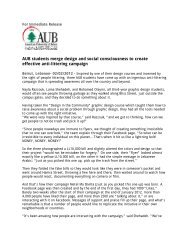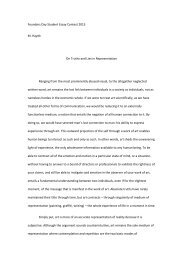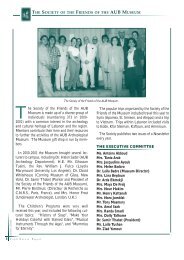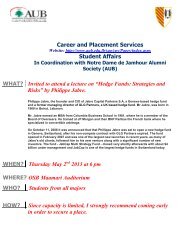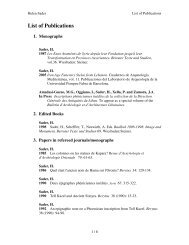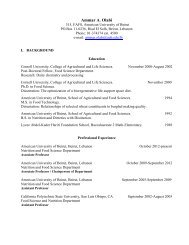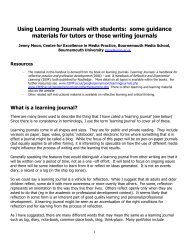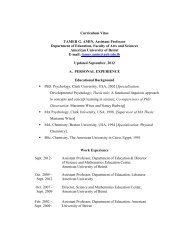The IX t h Makassed Medical Congress - American University of Beirut
The IX t h Makassed Medical Congress - American University of Beirut
The IX t h Makassed Medical Congress - American University of Beirut
You also want an ePaper? Increase the reach of your titles
YUMPU automatically turns print PDFs into web optimized ePapers that Google loves.
(P=0.006, odds ratio=4.59), respectively.<br />
IDA is common in Lebanese children and is associated with increased blood lead levels, lack <strong>of</strong><br />
iron supplementation, and cultural dietary habits. Remedial measures such as iron fortification <strong>of</strong><br />
commonly consumed food are needed on the national level. Lead exposure must be controlled<br />
and awareness must be raised about the potentially devastating consequences <strong>of</strong> combined<br />
iron deficiency and lead poisoning on young children.<br />
NON-INVASIVE VENTILATION IN CHILDREN: INDICATIONS AND PREDICTIVE<br />
FACTORS FOR THE OUTCOME<br />
Francis Leclerc MD-PhD<br />
Non-invasive ventilation (NIV) provides respiratory support without endotracheal tube or<br />
tracheostomy. It usually refers to continuous positive airway (CPAP) or bilevel positive airway<br />
pressure (BiPAP) delivered through nasal prongs, facemasks or head boxes. Many evidence is<br />
accumulating that it may be beneficial for children with acute respiratory failure (ARF). In a 5-year<br />
retrospective study, 83 <strong>of</strong> 114 children (77%) were treated successfully with NIV; the success rate<br />
was 100% for acute chest syndrome, 92% for immuno-compromised children, 87% for community<br />
acquired pneumonia, while only 22% for acute respiratory distress syndrome (ARDS) (1). In a<br />
3-year prospective study, 32 episodes <strong>of</strong> ARF in 26 children (pneumonia: 46%) were treated with<br />
NIV by a volumetric ventilator; there was a clinical (at 2-4 hours) and radiological (at 24 hours)<br />
improvement and only 4 children required intubation (2). <strong>The</strong> mechanism by which NIV acts was<br />
recently studied by Essouri et al. in 12 children with hypercapnic ARF by the mean <strong>of</strong> an esogastric<br />
catheter: the authors observed that NIV was associated with a significant improvement<br />
<strong>of</strong> breathing pattern, gas exchange and respiratory muscle output (3). Also, NIV limits alveolar<br />
collapse (1). NIV includes simpler technology and equipment allowing use in settings other<br />
than critical care units; this means that patients may benefit from additional respiratory support<br />
earlier in the progression <strong>of</strong> their illness. Furthermore, NIV is associated with less need for sedation<br />
and a decrease in nosocomial ventilator associated infections. This is, at least partly, due to<br />
the diminished need for intubation, as reported by Yanez et al in their prospective randomised<br />
controlled study (intubation rate: 60 % in controls, 28% in NIV group) (4).<br />
When use NIV for acute respiratory failure?<br />
Whilst for some problems, such as upper airway obstruction, stenting <strong>of</strong> the upper airway with<br />
CPAP is <strong>of</strong>ten adequate to improve overall ventilation, there are other conditions where additional<br />
BiPAP to enhance minute ventilation is used. For ARF, a combination <strong>of</strong> factors determines whether<br />
assisted ventilation is needed, most commonly the degree <strong>of</strong> respiratory distress and whether the<br />
child is tiring, exhausted, unable to vocalise, looking frightened, has altered conscious level or<br />
deteriorating vital signs. <strong>The</strong> child’s clinical condition usually guides the need for intubation and<br />
critical care, but continuous measurement <strong>of</strong> pulse oxygen saturation (SpO 2 ) and PtcCO 2 (5)<br />
(as NIV is generally used for hypercapnic ARF) may help identify the progression <strong>of</strong> respiratory<br />
failure and allow for earlier intervention with NIV. Several papers have summarized the published<br />
evidence on NIV for ARF in adult patients: the results are presented in table 1 (6-8). <strong>The</strong> authors<br />
<strong>of</strong> these meta-analyses concluded that NIV for ARF was supported by strong evidence from<br />
patients with chronic obstructive pulmonary disease, acute cardiogenic pulmonary edema<br />
59





